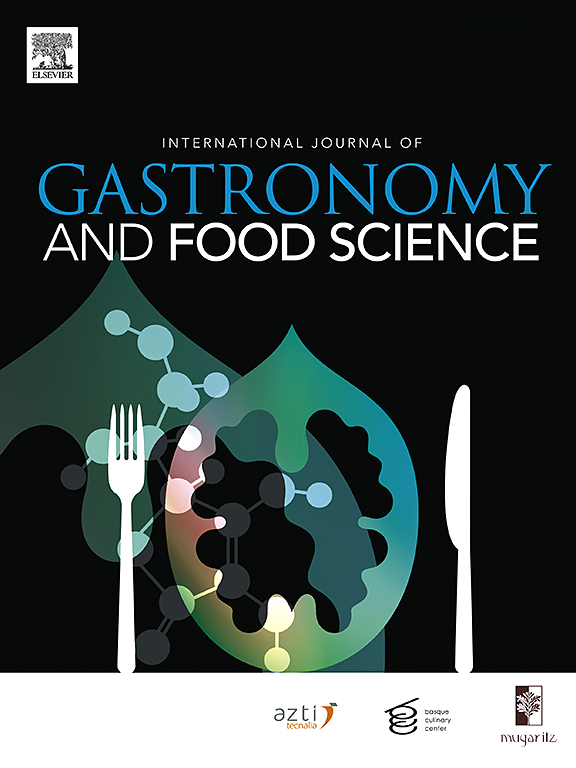Predictors of food neophobia among Turkish university students and its association with food choices from online Turkish restaurant menu
IF 3.2
2区 农林科学
Q2 FOOD SCIENCE & TECHNOLOGY
International Journal of Gastronomy and Food Science
Pub Date : 2024-12-10
DOI:10.1016/j.ijgfs.2024.101085
引用次数: 0
Abstract
The aim of this study was to investigate the factors associated with food neophobia (FN) among Turkish university students, with a particular focus on comparing FN levels between students in food-related and non-food-related programs. Additionally, the impact of FN on food choices was investigated. Three groups of students were recruited: cookery/gastronomy and culinary arts (COOK) students (n = 484), nutrition and dietetics/food engineering (NUTRI-FOOD) students (n = 448), and students from non-food-related (NON-FOOD) departments (n = 431). Data included socio-demographic information, the Food Neophobia Scale (FNS), and an online food choice experiment using Turkish restaurant and café menus. The menu included options designed to evoke neophobic responses in the categories of starter, soup, main course, dessert, and beverage. The results of the study indicated that students’ department, international experience, and socio-demographic factors were the determinants of FN among students. COOK students exhibited lower odds of medium (OR: 0.68, 95% CI 0.49–0.95) and high (OR: 0.33, 95% CI 0.23–0.46) FN compared to students in NON-FOOD programs. However, FN levels did not differ between NUTRI-FOOD and NON-FOOD students. Higher academic year, higher paternal education and experience of being abroad were associated with lower FN, whereas lower appetite, history of food poisoning and middle income were associated with higher FN. Moreover, FN was negatively correlated with familiarity with most of the menu items. FN significantly influenced food choice, with students exhibiting high FN less likely to choose unfamiliar foods from online restaurant and café menus. The results highlight the link between familiarity with Turkish cuisine, food choice and FN.
土耳其大学生新食物恐惧症的预测因素及其与在线土耳其餐馆菜单食物选择的关系
本研究的目的是调查土耳其大学生中与新食物恐惧症(FN)相关的因素,特别关注比较食物相关和非食物相关专业学生的FN水平。此外,FN对食物选择的影响也进行了调查。招募了三组学生:烹饪/美食与烹饪艺术(COOK)学生(n = 484),营养与营养学/食品工程(nutrition -food)学生(n = 448),以及来自非食品相关系(NON-FOOD)的学生(n = 431)。数据包括社会人口统计信息,新食物恐惧症量表(FNS),以及使用土耳其餐馆和咖啡馆菜单的在线食物选择实验。菜单上的选项包括前菜、汤、主菜、甜点和饮料,这些都是为了唤起人们对新事物的恐惧。研究结果显示,学生系系、国际经验和社会人口因素是学生FN的决定因素。与非食品项目的学生相比,COOK学生表现出较低的中等FN (OR: 0.68, 95% CI 0.49-0.95)和高FN (OR: 0.33, 95% CI 0.23-0.46)的几率。然而,FN水平在营养食品学生和非营养食品学生之间没有差异。较高的学年度、较高的父亲教育程度和出国经历与较低的FN相关,而较低的食欲、食物中毒史和中等收入与较高的FN相关。此外,FN与大多数菜单项的熟悉程度呈负相关。FN显著影响食物选择,表现出高FN的学生不太可能从网上餐馆和咖啡馆的菜单上选择不熟悉的食物。研究结果强调了对土耳其美食的熟悉程度、食物选择和FN之间的联系。
本文章由计算机程序翻译,如有差异,请以英文原文为准。
求助全文
约1分钟内获得全文
求助全文
来源期刊

International Journal of Gastronomy and Food Science
Social Sciences-Cultural Studies
CiteScore
5.30
自引率
10.50%
发文量
170
审稿时长
45 days
期刊介绍:
International Journal of Gastronomy and Food Science is a peer-reviewed journal that explicitly focuses on the interface of food science and gastronomy. Articles focusing only on food science will not be considered. This journal equally encourages both scientists and chefs to publish original scientific papers, review articles and original culinary works. We seek articles with clear evidence of this interaction. From a scientific perspective, this publication aims to become the home for research from the whole community of food science and gastronomy.
IJGFS explores all aspects related to the growing field of the interaction of gastronomy and food science, in areas such as food chemistry, food technology and culinary techniques, food microbiology, genetics, sensory science, neuroscience, psychology, culinary concepts, culinary trends, and gastronomic experience (all the elements that contribute to the appreciation and enjoyment of the meal. Also relevant is research on science-based educational programs in gastronomy, anthropology, gastronomic history and food sociology. All these areas of knowledge are crucial to gastronomy, as they contribute to a better understanding of this broad term and its practical implications for science and society.
 求助内容:
求助内容: 应助结果提醒方式:
应助结果提醒方式:


